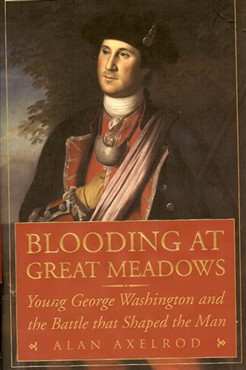|
Young George Washington and the Battle that
Shaped the Man
By Alan Axelrod
Reviewed
by Frank R. Shaw, FSA SCOT,
Atlanta, GA, USA, email:
jurascot@earthlink.net
 Author
Alan Axelrod has written an interesting and compelling book which gives us a
new, insightful look into young George Washington! Any student of history or
Washington will find Blooding at Great Meadows a wonderful and
stimulating read, beginning with the title itself. This book is simply as
good a book on Washington’s early years as one can find. Author
Alan Axelrod has written an interesting and compelling book which gives us a
new, insightful look into young George Washington! Any student of history or
Washington will find Blooding at Great Meadows a wonderful and
stimulating read, beginning with the title itself. This book is simply as
good a book on Washington’s early years as one can find.
The section
dealing with Washington’s defeat at Fort Necessity (a/k/a Great Meadows) in
the western part of what is now Pennsylvania is material worthy of being
made into a movie. “Why?” you ask. Because Axelrod’s chapter titled “Anatomy
of Surrender” deals with the first of Washington’s many defeats during his
military career, and his only battlefield surrender!
Leading his first major command, Washington, having been given the honors of
war, marched out of Fort Necessity with drums beating and colors raised
high. He picked a fight with a superior force and lost. To put it mildly, he
simply got thrashed! Although humiliated, young George Washington marched
out of Fort Necessity “a soldier, a leader of soldiers - and more”. The
French and Indian War had begun and would last seven years. And in a
staccato sentence, the author reveals, “The day was July 4, 1754.” But
Washington would experience another July 4, this one in 1776, and it would
have a different ending.
The
22-year-old Washington returned from his humiliation at Great Meadows,
Axelrod writes, neither shocked, cowed, or chastened. He returned bloodied,
now a mature soldier, and could recall something charming in the sound of
bullets whistling by his head. Axelrod says of Washington that he “fought,
led, watched, and learned. Washington survived. More than that, he
prevailed.” And, history was to record George Washington as a great leader
of men but not a great tactician. Choosing to build Fort Necessity on the
site he did was the first of many errors in judgment that Washington would
make over a long, distinguished career. After the surrender, it took
Washington and his men nearly two weeks to reach Williamsburg where he was
generally greeted as a hero since most of his critics were silent. But, that
was not the end of the matter.
Horace
Walpole said it better than anyone else when he wrote in his Memoirs
of the Reign of King George II, “The volley fired by a young
Virginian in the backwoods of America set the world on fire”. The book’s
subtitle, “Young George Washington and the Battle that Shaped the Man” could
just as easily have been “Young George Washington Who As a Man Would One Day
Shape the World”.
Ask for
Blooding at Great Meadows (Running Press Book Publishers) at your
local book store - ISBN-13: 978-0-7624-2769-7 or ISBN-10: 0-7624-2769-8.
This publication lists for $22.95, and you’ll be glad you added it to your
library. (FRS: 8-06-07)
Now, What
Has This Got To Do With Scottishness?
With all
due apologies to Alan Axelrod, I will venture into another area of interest
to our Scottish readers that has nothing to do with his book. It was Light
Horse Henry Lee (father of General Robert E. Lee) in his eulogy of
Washington who described him as “First in peace, first in war, first in the
hearts of his countrymen.” He has often been referred to as an Englishman
throughout history. One author and Scottish scholar, Duncan Bruce (The
Mark of the Scots and The Scottish 100), notes that
Washington was of “solid English stock”.
However,
Bruce goes on to say in The Mark of the Scots that an unusual
discovery was made in 1964 by George S. H. L. Washington, himself an
Englishman, who found that our George Washington had a Scottish connection
to Malcolm II, King of Scotland from
1005-1034. Listen up, this information
has been verified and accepted by the Garter King of Arms, the official
arbiter of English genealogy. Bruce supports this discovery, as did Nigel
Tranter, “Scotland’s Story Teller”. I certainly have found no reason not to!
And that, dear reader, is why I’ve reviewed this excellent book by Alan
Axelrod on the young George Washington! (FRS: 8-06-07) |
